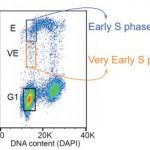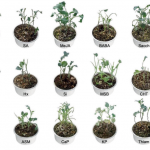Plant Science Research Weekly: July 3rd
Review: Feedback mechanisms between membrane lipid homeostasis and plant development
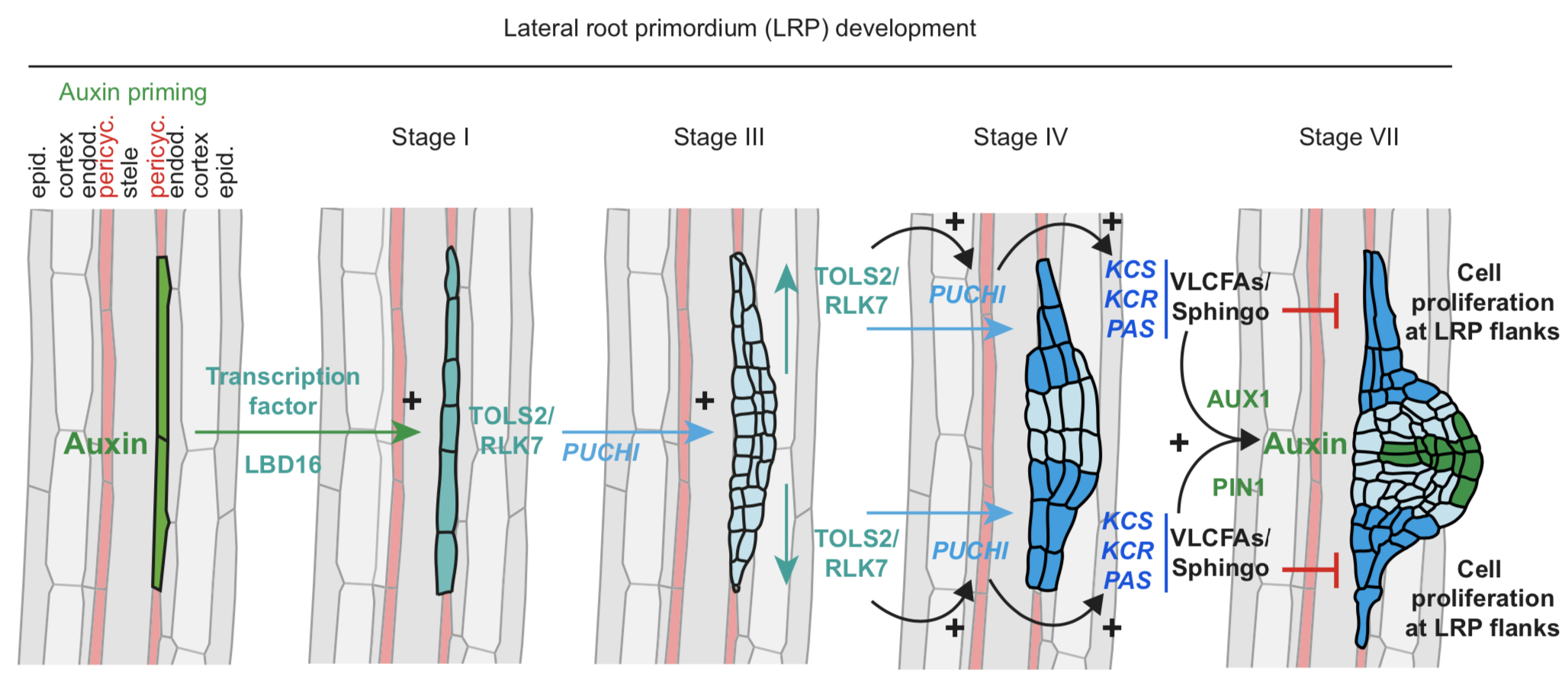 Plant development is a regulated process of cell division, expansion, and differentiation. Membrane lipids are crucial to these processes, as illustrated in this review by Boutté and Jaillais. The authors discuss the major lipid components in the different membrane systems and how these vary in space and time during plant development. Taking examples from Arabidopsis root development, the authors explain how auxin impinges on lipid homeostasis which in turn feedbacks to the auxin pathway. As an example, the pasticcino (pas) mutants display ectopic cell proliferation, and PAS is involved in the synthesis of very-long chain fatty acids (VLCFAs). Analysis of this and other mutants revealed the critical role for appropriate VLCFA production in hormone signaling and several developmental processes. The authors also discuss the role of lipids that help in concentrating signaling proteins on the membranes and thus activating the downstream signaling pathways, the significance of electrostatic interactions and lipid gradients in brassinosteroid and auxin pathways, and the regulation of cell-cell communication and cell polarity by lipids. Thus, this review provides a comprehensive view of the significance of lipid homeostasis and concludes with the emphasis on the much-needed attention required for the lipid homeostasis in plant development. Summary by (Vijaya Batthula @Vijaya_Batthula). Dev. Cell 10.1016/j.devcel.2020.05.005
Plant development is a regulated process of cell division, expansion, and differentiation. Membrane lipids are crucial to these processes, as illustrated in this review by Boutté and Jaillais. The authors discuss the major lipid components in the different membrane systems and how these vary in space and time during plant development. Taking examples from Arabidopsis root development, the authors explain how auxin impinges on lipid homeostasis which in turn feedbacks to the auxin pathway. As an example, the pasticcino (pas) mutants display ectopic cell proliferation, and PAS is involved in the synthesis of very-long chain fatty acids (VLCFAs). Analysis of this and other mutants revealed the critical role for appropriate VLCFA production in hormone signaling and several developmental processes. The authors also discuss the role of lipids that help in concentrating signaling proteins on the membranes and thus activating the downstream signaling pathways, the significance of electrostatic interactions and lipid gradients in brassinosteroid and auxin pathways, and the regulation of cell-cell communication and cell polarity by lipids. Thus, this review provides a comprehensive view of the significance of lipid homeostasis and concludes with the emphasis on the much-needed attention required for the lipid homeostasis in plant development. Summary by (Vijaya Batthula @Vijaya_Batthula). Dev. Cell 10.1016/j.devcel.2020.05.005
Review. Plant nutrition for human nutrition: Hints from rice research and future perspectives
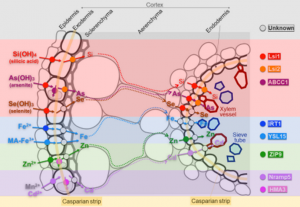 Among all the mineral elements transported from the soil to the plant, cadmium (Cd) and arsenic (As)- are toxic for all organisms whereas 13 micronutrients, including iron (Fe) and zinc (Zn), are beneficial for both human and plant nutrition. Ideally, food crops should accumulate fewer soil contaminants but more essential elements in their edible portions. This is particularly important for diets based on cereals, as low amounts and low bioavailability of mineral elements in the grains can lead to micronutrient deficiency in humans, causing serious health problems. In this article, Huang and colleagues review the most significant mineral element transporters identified in rice and discuss their manipulation to produce healthy and safe food. As an example, overexpression of the Heavy Metal ATPase OsHMA3 leads to increased Cd sequestration in root cell vacuoles, resulting in decreased Cd translocation to the shoot and reduced Cd accumulation in seeds. The authors also highlight challenges related to the strict mechanisms controlling homeostasis of mineral elements, as altering their accumulation to meet the requirements for human nutrition might be detrimental for plant growth. However, alternative strategies could overcome this problem. Indeed, mutations in the SULTR-type proton-phosphate symporter OsSPDT lead to decreased levels of phytic acid (a strong Fe and Zn chelator) and consequently to increased bioavailability of these essential elements in rice grains without yield penalty. The authors conclude that a comprehensive understanding of the entire transport system is the first step towards obtaining novel cereal crops with improved nutritional value and reduced toxicity. (Summary and image adaptation by Michela Osnato @michela_osnato) Mol. Plant 10.1016/j.molp.2020.05.007
Among all the mineral elements transported from the soil to the plant, cadmium (Cd) and arsenic (As)- are toxic for all organisms whereas 13 micronutrients, including iron (Fe) and zinc (Zn), are beneficial for both human and plant nutrition. Ideally, food crops should accumulate fewer soil contaminants but more essential elements in their edible portions. This is particularly important for diets based on cereals, as low amounts and low bioavailability of mineral elements in the grains can lead to micronutrient deficiency in humans, causing serious health problems. In this article, Huang and colleagues review the most significant mineral element transporters identified in rice and discuss their manipulation to produce healthy and safe food. As an example, overexpression of the Heavy Metal ATPase OsHMA3 leads to increased Cd sequestration in root cell vacuoles, resulting in decreased Cd translocation to the shoot and reduced Cd accumulation in seeds. The authors also highlight challenges related to the strict mechanisms controlling homeostasis of mineral elements, as altering their accumulation to meet the requirements for human nutrition might be detrimental for plant growth. However, alternative strategies could overcome this problem. Indeed, mutations in the SULTR-type proton-phosphate symporter OsSPDT lead to decreased levels of phytic acid (a strong Fe and Zn chelator) and consequently to increased bioavailability of these essential elements in rice grains without yield penalty. The authors conclude that a comprehensive understanding of the entire transport system is the first step towards obtaining novel cereal crops with improved nutritional value and reduced toxicity. (Summary and image adaptation by Michela Osnato @michela_osnato) Mol. Plant 10.1016/j.molp.2020.05.007
Review. Endosperm variability: From endoreduplication within a seed to higher ploidy across species, and its competence ($)
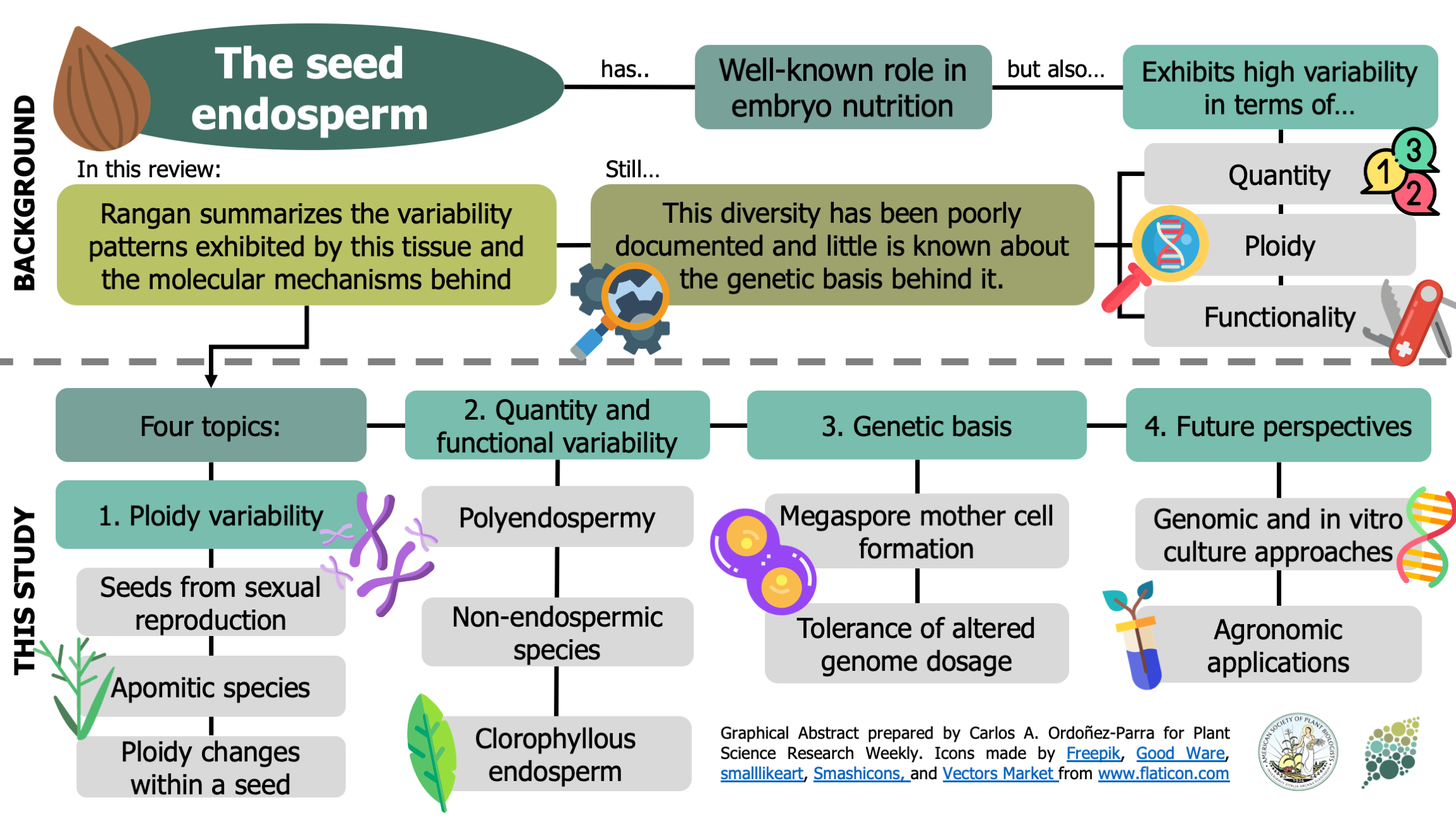 In addition to its well-known nutritive function, the endosperm of seeds has a great deal of morphological, genomic and functional diversity. In this review, Rangan summarizes endosperm variability and the molecular mechanisms behind it. Although classically described as being triploid (2n from the mother and n from the father), in reality endosperm ploidy is hugely variable across species, spanning from 2n-15n. Furthermore, paternal and maternal contributions differ between seeds that originate from sexual reproduction from those arising from the different forms of apomixis. Additionally, endoreduplication within the endosperm can increase its variability within a seed. Current information about the genetic basis behind this variability is discussed, emphasizing the potential roles of genes that regulate the cell cycle in endosperm development. The author observes that our knowledge about endosperm development is highly limited and largely based on Arabidopsis thaliana. The review concludes by outlining a “roadmap for understanding the endosperm genome variability,” highlighting the genomics and in vitro tissue culture approaches that can increase our understanding of the origin of this tissue diversity, and the potential agricultural applications that can arise in the process. (Summary by Carlos A. Ordóñez-Parra @caordonezparra) Seed Sci. Res. 10.1017/S0960258520000148
In addition to its well-known nutritive function, the endosperm of seeds has a great deal of morphological, genomic and functional diversity. In this review, Rangan summarizes endosperm variability and the molecular mechanisms behind it. Although classically described as being triploid (2n from the mother and n from the father), in reality endosperm ploidy is hugely variable across species, spanning from 2n-15n. Furthermore, paternal and maternal contributions differ between seeds that originate from sexual reproduction from those arising from the different forms of apomixis. Additionally, endoreduplication within the endosperm can increase its variability within a seed. Current information about the genetic basis behind this variability is discussed, emphasizing the potential roles of genes that regulate the cell cycle in endosperm development. The author observes that our knowledge about endosperm development is highly limited and largely based on Arabidopsis thaliana. The review concludes by outlining a “roadmap for understanding the endosperm genome variability,” highlighting the genomics and in vitro tissue culture approaches that can increase our understanding of the origin of this tissue diversity, and the potential agricultural applications that can arise in the process. (Summary by Carlos A. Ordóñez-Parra @caordonezparra) Seed Sci. Res. 10.1017/S0960258520000148
The genome of Prasinoderma coloniale unveils the existence of a third phylum within green plants
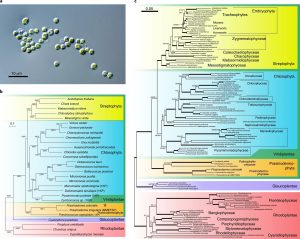 The green plant lineage (Viridiplantae) has long been described as having a single origin (starting with the engulfment of a cyanobacteria-like endosymbiont) that has led to two phyla: the Streptophyta, including embryophytes (land plants) and some algae such as chara and nitella, and the Chlorophyta, encompassing most of the other algae including chlamydomonas, volvox, chlorella, and ostreococcus. Now, Li et al. have sequenced a tiny unicellular alga isolated from deep in the water column and found that it represents a distinct, third phylum, which they call the Prasinodermaphyta, which split off before the divergence of the Streptophyta and Chlorophyta. This new phylum provides new insights into the very earliest days of the Viridiplantae, and provides a unique opportunity to reconstruct the minimum core genome of Viridiplantae. (Summary by Mary Williams @PlantTeaching) Nature Ecol. Evol. 10.1038/s41559-020-1221-7
The green plant lineage (Viridiplantae) has long been described as having a single origin (starting with the engulfment of a cyanobacteria-like endosymbiont) that has led to two phyla: the Streptophyta, including embryophytes (land plants) and some algae such as chara and nitella, and the Chlorophyta, encompassing most of the other algae including chlamydomonas, volvox, chlorella, and ostreococcus. Now, Li et al. have sequenced a tiny unicellular alga isolated from deep in the water column and found that it represents a distinct, third phylum, which they call the Prasinodermaphyta, which split off before the divergence of the Streptophyta and Chlorophyta. This new phylum provides new insights into the very earliest days of the Viridiplantae, and provides a unique opportunity to reconstruct the minimum core genome of Viridiplantae. (Summary by Mary Williams @PlantTeaching) Nature Ecol. Evol. 10.1038/s41559-020-1221-7
Mutation bias shapes gene evolution in Arabidopsis thaliana
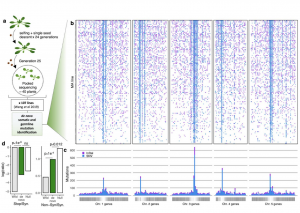 Classical evolutionary theory states that the probability of a mutation occurring is independent of fitness consequences. However, reassessment of traditional assumptions is warranted with recent discoveries showing that cytogenetic (DNA sequences and epigenetic) features can affect local mutation probabilities. Cytogenetic features have distinct states among certain gene classes which may facilitate the evolution of beneficial mutation rates. To test whether mutation rate bias can be adaptive, Monroe et al. built a high-resolution predictive model of mutation rates in Arabidopsis (see the Twitter thread here). This model was developed using 10,500 de novo mutations from sequencing 107 mutation accumulation lines alongside genome-wide data (histone modifications, chromatin accessibility, GC-content). This model resulted in three main findings. Firstly, cytogenetic features significantly predict mutation rates (e.g., lower mutation rates in GC-rich regions). Secondly, introns and untranslated regions physically distance coding sequences from mutation hotspots, with higher mutation rates in genes lacking UTRs or introns (30-40% and 90%, respectively). Finally, genes sensitive to deleterious mutations possess lower coding-region mutation rates. Intriguingly, these findings were mirrored in natural variation patterns. The authors’ explanation for these observations is that selection on mutation rate is not at the gene-level, but epigenetic features differentially direct DNA repair machinery recruitment. These discoveries contradict the classical evolutionary theory that mutation probabilities are independent of gene function and fitness consequences, signifying an important breakthrough in our understanding of gene evolution. In a new approach, the authors have released a comments-enabled google doc so that the wider community can provide feedback on the manuscript, which is available here. (Summary by Caroline Dowling @CarolineD0wling) bioRxiv 10.1101/2020.06.17.156752.
Classical evolutionary theory states that the probability of a mutation occurring is independent of fitness consequences. However, reassessment of traditional assumptions is warranted with recent discoveries showing that cytogenetic (DNA sequences and epigenetic) features can affect local mutation probabilities. Cytogenetic features have distinct states among certain gene classes which may facilitate the evolution of beneficial mutation rates. To test whether mutation rate bias can be adaptive, Monroe et al. built a high-resolution predictive model of mutation rates in Arabidopsis (see the Twitter thread here). This model was developed using 10,500 de novo mutations from sequencing 107 mutation accumulation lines alongside genome-wide data (histone modifications, chromatin accessibility, GC-content). This model resulted in three main findings. Firstly, cytogenetic features significantly predict mutation rates (e.g., lower mutation rates in GC-rich regions). Secondly, introns and untranslated regions physically distance coding sequences from mutation hotspots, with higher mutation rates in genes lacking UTRs or introns (30-40% and 90%, respectively). Finally, genes sensitive to deleterious mutations possess lower coding-region mutation rates. Intriguingly, these findings were mirrored in natural variation patterns. The authors’ explanation for these observations is that selection on mutation rate is not at the gene-level, but epigenetic features differentially direct DNA repair machinery recruitment. These discoveries contradict the classical evolutionary theory that mutation probabilities are independent of gene function and fitness consequences, signifying an important breakthrough in our understanding of gene evolution. In a new approach, the authors have released a comments-enabled google doc so that the wider community can provide feedback on the manuscript, which is available here. (Summary by Caroline Dowling @CarolineD0wling) bioRxiv 10.1101/2020.06.17.156752.
Plastocyanin is the long-range electron carrier between photosystem II and photosystem I in plants
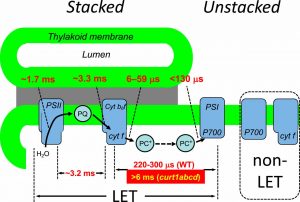 In linear electron transport (LET), electrons are passed from photosystem II to photosystem I, but it has not been clear which of two mobile electron carriers is responsible, plastocyanin (PC) or plastoquinone (PQ). PQ carries electrons from PSII to the cyt b6f complex and PC from there to PSI. Höhner et al. have taken advantage of an Arabidopsis mutant affected in a protein that controls thylakoid shape, Curvature Thylakoid 1 (CURT1). Normally, thylakoids form stacks of grana that are about 400 nm in diameter, but in the quadruple curt1abcd mutant the grana average diameter is 1600 nm. Because PSII accumulates in the grana and PSI in the unstacked stroma, the authors reasoned that the movement of electrons from PSII in the grana to PSI beyond the margin of the grana would take longer in the mutant. The authors then measured PC and PQ-dependent electron transfer (by the clever use of light pulses and conditions) in the mutant and found that only the PC-dependent transport was affected, indicating it is the long-range electron carrier. The authors conclude, “The fact that the PC diffusion becomes much slower if the grana diameter exceeds ∼500 nm suggests that a restriction of the grana diameter is essential to keep PC-mediated long-range electron transport within reasonable rates to allow fast and efficient LET.” (Summary by Mary Williams @PlantTeaching) Proc. Natl. Acad. Sci. USA 10.1073/pnas.2005832117
In linear electron transport (LET), electrons are passed from photosystem II to photosystem I, but it has not been clear which of two mobile electron carriers is responsible, plastocyanin (PC) or plastoquinone (PQ). PQ carries electrons from PSII to the cyt b6f complex and PC from there to PSI. Höhner et al. have taken advantage of an Arabidopsis mutant affected in a protein that controls thylakoid shape, Curvature Thylakoid 1 (CURT1). Normally, thylakoids form stacks of grana that are about 400 nm in diameter, but in the quadruple curt1abcd mutant the grana average diameter is 1600 nm. Because PSII accumulates in the grana and PSI in the unstacked stroma, the authors reasoned that the movement of electrons from PSII in the grana to PSI beyond the margin of the grana would take longer in the mutant. The authors then measured PC and PQ-dependent electron transfer (by the clever use of light pulses and conditions) in the mutant and found that only the PC-dependent transport was affected, indicating it is the long-range electron carrier. The authors conclude, “The fact that the PC diffusion becomes much slower if the grana diameter exceeds ∼500 nm suggests that a restriction of the grana diameter is essential to keep PC-mediated long-range electron transport within reasonable rates to allow fast and efficient LET.” (Summary by Mary Williams @PlantTeaching) Proc. Natl. Acad. Sci. USA 10.1073/pnas.2005832117
Vacuolar channel CLCa is involved in guard cell pH homeostasis
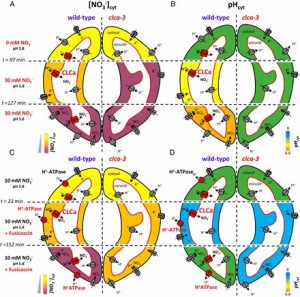 In plants, stomata are involved in a host of responses, controlled by ion homeostasis in guard cells. In an attempt to understand the function of a plant chloride channel (CLC), CLCa, which transports chloride (Cl–) and nitrate (NO3–) in guard cells, Demes and colleagues sought to establish a relationship between ion transport and pH regulation by the channel. To this end, they used a fluorescent sensor named ClopHensor, developed for use in mammalian cells. Briefly, it uses a chloride- and pH-sensitive GFP that is fused to DsRed. Excitation with different wavelengths of light and ratiometric analysis allow for the simultaneous measurement of Cl– (or other anions), and pH. In plant cells, the authors found that ClopHensor is a good indicator for the concentration of NO3–, but not sensitive to the physiological levels of Cl– . They then used this probe to explore how guard cells behave when the vacuolar chloride channel is knocked out. In wild-type plants, the authors found that NO3– uptake directly correlates with acidification of guard cell cytosol. Contrarily in clca mutants, it was found that there is no significant acidification upon addition of NO3–, hinting at a role for NO3‑/H+ exchange activity of CLCa. Going deeper, the authors applied fungal toxin fusicoccin, which activates the plasma-membrane H+ pump, to wild type and mutant guard cells; while the pH in both increased after fusicoccin treatment, that of mutant plants failed to recover, showing that CLCa can induce changes in pH (through H+ transport) independent of anion transport. (Summary by Pavithran Narayanan @pavi_narayanan) Proc. Natl. Acad. Sci. USA
In plants, stomata are involved in a host of responses, controlled by ion homeostasis in guard cells. In an attempt to understand the function of a plant chloride channel (CLC), CLCa, which transports chloride (Cl–) and nitrate (NO3–) in guard cells, Demes and colleagues sought to establish a relationship between ion transport and pH regulation by the channel. To this end, they used a fluorescent sensor named ClopHensor, developed for use in mammalian cells. Briefly, it uses a chloride- and pH-sensitive GFP that is fused to DsRed. Excitation with different wavelengths of light and ratiometric analysis allow for the simultaneous measurement of Cl– (or other anions), and pH. In plant cells, the authors found that ClopHensor is a good indicator for the concentration of NO3–, but not sensitive to the physiological levels of Cl– . They then used this probe to explore how guard cells behave when the vacuolar chloride channel is knocked out. In wild-type plants, the authors found that NO3– uptake directly correlates with acidification of guard cell cytosol. Contrarily in clca mutants, it was found that there is no significant acidification upon addition of NO3–, hinting at a role for NO3‑/H+ exchange activity of CLCa. Going deeper, the authors applied fungal toxin fusicoccin, which activates the plasma-membrane H+ pump, to wild type and mutant guard cells; while the pH in both increased after fusicoccin treatment, that of mutant plants failed to recover, showing that CLCa can induce changes in pH (through H+ transport) independent of anion transport. (Summary by Pavithran Narayanan @pavi_narayanan) Proc. Natl. Acad. Sci. USA
MscS-like 10 as a cell swelling sensor and promotes hypo-osmotic shock responses
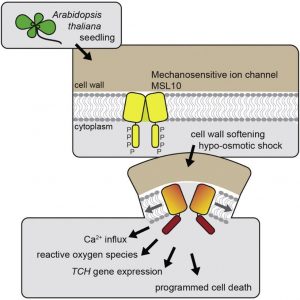 Optimal volume and turgor in the plant cell is important for metabolism, development and growth. Excessive diffusion of water into the cell will cause extreme swelling and a loss of cellular integrity. Members of the plasma membrane MscS-like (MSL) family of mechanosensitive (MS) ion channels play a role in osmotic homeostasis, but their direct function in cell swelling perception and signal transduction have not been determined. Basu and Haswell demonstrated a new assay to investigate cell swelling; the assay involves cell wall softening (through the use of a cellulase synthesis inhibitor) and hypo-osmotic media. Through this, they showed that the MS ion channel MSL10 is a cell swelling sensor and is required for cell swelling responses, using both loss-of-function and gain-of-function alleles. These studies show that in response to cell-swelling, MSL10 promotes cell-swelling induced cell death, increases cytoplasmic calcium and reactive oxygen species (ROS) accumulation, induces gene expression of hypo-osmotic shock-associated genes, and potentiates cell swelling induced programmed cell death (PCD). Interestingly, substitution of the phosphorylation residues at the N-terminal domain of MSL10 to an aspartate phosphomimic residue prevents cell swelling-induced PCD. Overall, this study supports the model of MSL10 as the primary plasma-membrane-based cell swelling sensor and sheds the light for future molecular exploration of the signaling pathway. (Summary by Min May Wong @wongminmay) Curr. Biol. 10.1016/j.cub.2020.05.015
Optimal volume and turgor in the plant cell is important for metabolism, development and growth. Excessive diffusion of water into the cell will cause extreme swelling and a loss of cellular integrity. Members of the plasma membrane MscS-like (MSL) family of mechanosensitive (MS) ion channels play a role in osmotic homeostasis, but their direct function in cell swelling perception and signal transduction have not been determined. Basu and Haswell demonstrated a new assay to investigate cell swelling; the assay involves cell wall softening (through the use of a cellulase synthesis inhibitor) and hypo-osmotic media. Through this, they showed that the MS ion channel MSL10 is a cell swelling sensor and is required for cell swelling responses, using both loss-of-function and gain-of-function alleles. These studies show that in response to cell-swelling, MSL10 promotes cell-swelling induced cell death, increases cytoplasmic calcium and reactive oxygen species (ROS) accumulation, induces gene expression of hypo-osmotic shock-associated genes, and potentiates cell swelling induced programmed cell death (PCD). Interestingly, substitution of the phosphorylation residues at the N-terminal domain of MSL10 to an aspartate phosphomimic residue prevents cell swelling-induced PCD. Overall, this study supports the model of MSL10 as the primary plasma-membrane-based cell swelling sensor and sheds the light for future molecular exploration of the signaling pathway. (Summary by Min May Wong @wongminmay) Curr. Biol. 10.1016/j.cub.2020.05.015
Reprogramming of stem cell activity to convert thorns into branches
 Thorns are modified axillary shoots with a sharp tip that helps in deterring herbivores and are found among several families of angiosperms. Thorns develop from their meristem-like tip to their base, but unlike branches they are determinate organs. The mechanism of their terminal differentiation into a sharp structure is not known. In this paper, Zhang et al. identified the role of two genes in citrus thorn development that are orthologs of Arabidopsis class II TCP genes. Using transcriptomic analysis to compare between citrus species with and without thorns, the authors identified THORN INDUCED1 (TI1) as being highly expressed in thorn primordia in species with thorns, and also identified another closely related gene TI2 with a similar expression pattern. Using CRISPR and RNAi methods, the authors generated mutants of TI1 and 2 which developed shoot branches instead of thorns, making plants bushier. Gene expression analysis showed that TI1 represses CsWUS by binding to its upstream region. Thus, this paper advances our understanding of thorn formation and opens the door to the modification of TI1 and 2 for improved agronomical purposes. Summary by (Vijaya Batthula, @Vijaya_Batthula) Curr. Bio 10.1016/j.cub.2020.05.068.
Thorns are modified axillary shoots with a sharp tip that helps in deterring herbivores and are found among several families of angiosperms. Thorns develop from their meristem-like tip to their base, but unlike branches they are determinate organs. The mechanism of their terminal differentiation into a sharp structure is not known. In this paper, Zhang et al. identified the role of two genes in citrus thorn development that are orthologs of Arabidopsis class II TCP genes. Using transcriptomic analysis to compare between citrus species with and without thorns, the authors identified THORN INDUCED1 (TI1) as being highly expressed in thorn primordia in species with thorns, and also identified another closely related gene TI2 with a similar expression pattern. Using CRISPR and RNAi methods, the authors generated mutants of TI1 and 2 which developed shoot branches instead of thorns, making plants bushier. Gene expression analysis showed that TI1 represses CsWUS by binding to its upstream region. Thus, this paper advances our understanding of thorn formation and opens the door to the modification of TI1 and 2 for improved agronomical purposes. Summary by (Vijaya Batthula, @Vijaya_Batthula) Curr. Bio 10.1016/j.cub.2020.05.068.
Genes of the RAV family control heading date and carpel development in rice
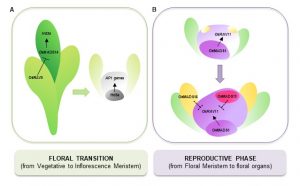 Seed-bearing annual plants essentially get one shot at getting their reproductive timing right; too early and there won’t be enough stored nutrients to produce healthy seeds, and too late and the seeds might not mature fully before bad weather or rot sets in. Previously, the RAV (RELATED TO ABI3 AND VP1) family of transcription factors was shown to have a role in delaying flowering time in Arabidopsis, specifically by repressing expression of the FT gene and genes encoding gibberellin biosynthesis, as well as other functions. Here, Osnato et al. examined the RAV genes in rice. One, OsRAV9 (also known as OsTEM1), was shown to repress flowering time in functional studies of both rice and Arabidopsis, although in rice the effect appears to be indirect, acting through MADS-box genes, rather than direct. Other OsRAV genes were found to contribute to carpel development, a function that is distinct from the corresponding Arabidopsis genes. In short, the rice RAV genes have some functional overlap with those from Arabidopsis and some distinct functions in development. (Summary by Mary Williams @PlantTeaching) Plant Physiol. 10.1104/pp.20.00562
Seed-bearing annual plants essentially get one shot at getting their reproductive timing right; too early and there won’t be enough stored nutrients to produce healthy seeds, and too late and the seeds might not mature fully before bad weather or rot sets in. Previously, the RAV (RELATED TO ABI3 AND VP1) family of transcription factors was shown to have a role in delaying flowering time in Arabidopsis, specifically by repressing expression of the FT gene and genes encoding gibberellin biosynthesis, as well as other functions. Here, Osnato et al. examined the RAV genes in rice. One, OsRAV9 (also known as OsTEM1), was shown to repress flowering time in functional studies of both rice and Arabidopsis, although in rice the effect appears to be indirect, acting through MADS-box genes, rather than direct. Other OsRAV genes were found to contribute to carpel development, a function that is distinct from the corresponding Arabidopsis genes. In short, the rice RAV genes have some functional overlap with those from Arabidopsis and some distinct functions in development. (Summary by Mary Williams @PlantTeaching) Plant Physiol. 10.1104/pp.20.00562
Plant-herbivore chemical communication decoded
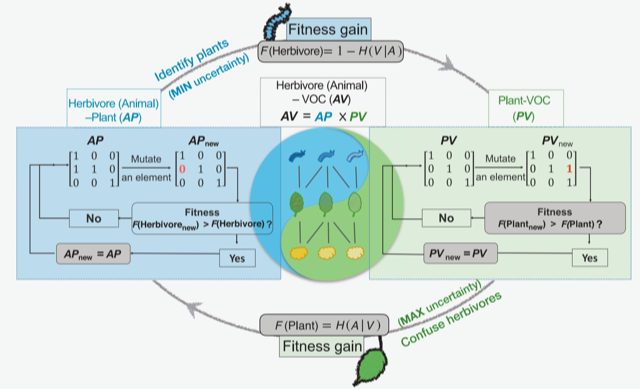 Chemical communications between species are prevalent in nature. For instance, herbivorous insects can spot their host plants by sensing volatile organic compounds (VOCs) emitted by plants. Despite our knowledge about interactions between individual plant and herbivore species, little is known about how chemical communications are structured and maintained in the ecological context. Zu et al. hypothesized that chemical communications between plants and herbivores are shaped by conflicting optimization processes; plants try to decrease the ability of herbivores to detect the right host (in other words, the herbivores’ decoding efficiency) by changing the suite of VOCs they produce. At the same time, herbivores try to increase their decoding efficiency to correctly identify edible plants. In this model, herbivore fitness is proportional to the decoding efficiency, and plant fitness is negatively proportional to it. To validate the model, the authors conducted fieldwork in a tropical dry forest, in which they collected larvae found on plant leaves and sampled VOCs from individual plant species. They then created matrices of plant-herbivore association and plant-VOC association; these two can be combined to generate herbivore-VOC association matrices, which define the decoding efficiency of herbivores. The authors showed that the simulation based on their model could explain key parameters, including the fitness of plants and herbivores observed in the field study. The model suggested that the conflicting optimization process (“information arms race”) drives plants to produce VOCs shared among other plant species to confuse herbivores at the community level, and this potentially pressures herbivores to specialize on a small number of plant species. This study proposes a theoretical framework explaining critical drivers of the formation and maintenance of multi-trophic interactions. (Summary by Tatsuya Nobori @nobolly) Science 10.1126/science.
Chemical communications between species are prevalent in nature. For instance, herbivorous insects can spot their host plants by sensing volatile organic compounds (VOCs) emitted by plants. Despite our knowledge about interactions between individual plant and herbivore species, little is known about how chemical communications are structured and maintained in the ecological context. Zu et al. hypothesized that chemical communications between plants and herbivores are shaped by conflicting optimization processes; plants try to decrease the ability of herbivores to detect the right host (in other words, the herbivores’ decoding efficiency) by changing the suite of VOCs they produce. At the same time, herbivores try to increase their decoding efficiency to correctly identify edible plants. In this model, herbivore fitness is proportional to the decoding efficiency, and plant fitness is negatively proportional to it. To validate the model, the authors conducted fieldwork in a tropical dry forest, in which they collected larvae found on plant leaves and sampled VOCs from individual plant species. They then created matrices of plant-herbivore association and plant-VOC association; these two can be combined to generate herbivore-VOC association matrices, which define the decoding efficiency of herbivores. The authors showed that the simulation based on their model could explain key parameters, including the fitness of plants and herbivores observed in the field study. The model suggested that the conflicting optimization process (“information arms race”) drives plants to produce VOCs shared among other plant species to confuse herbivores at the community level, and this potentially pressures herbivores to specialize on a small number of plant species. This study proposes a theoretical framework explaining critical drivers of the formation and maintenance of multi-trophic interactions. (Summary by Tatsuya Nobori @nobolly) Science 10.1126/science.
Induced tolerance to abiotic and biotic stresses of broccoli and Arabidopsis after treatment with elicitor molecules
 Plant hormones such as jasmonates (JAs) and salicylic acid (SA) are known for their role in regulating plant growth under both abiotic and biotic stresses. These hormones, which are synthesized within the plant, can modulate cellular processes in targeted cells locally and can be moved to other parts of the plant. Aside from plant hormones, certain foreign molecules also enhance the synthesis of metabolites that can protect crops from diseases, stress and damage. These compounds, called elicitor molecules, have not been widely applied in agriculture due to poor knowledge of their responses to stress, mode and dosage of application and efficacy under various environmental conditions. Here, Venegas-Molina et al. evaluated the mechanism of action of 14 elicitor molecules against a range of biotic and abiotic stresses in broccoli and Arabidopsis. They also studied the relationship between the elicitor molecules and some plant hormones through evaluating the drought recovery rate and relative water content in SA-mediated drought induced plants. The authors observed that elicitor molecules play an important role in stimulating defense responses to diverse kinds of plant stresses in a dose-dependent manner. This study suggests an environmentally friendly, cheap and long lasting option for the control of abiotic and biotic stresses in plants. (Summary by Modesta Abugu @modestannedi). Scientific Reports 10.1038/s41598-020-67074-7
Plant hormones such as jasmonates (JAs) and salicylic acid (SA) are known for their role in regulating plant growth under both abiotic and biotic stresses. These hormones, which are synthesized within the plant, can modulate cellular processes in targeted cells locally and can be moved to other parts of the plant. Aside from plant hormones, certain foreign molecules also enhance the synthesis of metabolites that can protect crops from diseases, stress and damage. These compounds, called elicitor molecules, have not been widely applied in agriculture due to poor knowledge of their responses to stress, mode and dosage of application and efficacy under various environmental conditions. Here, Venegas-Molina et al. evaluated the mechanism of action of 14 elicitor molecules against a range of biotic and abiotic stresses in broccoli and Arabidopsis. They also studied the relationship between the elicitor molecules and some plant hormones through evaluating the drought recovery rate and relative water content in SA-mediated drought induced plants. The authors observed that elicitor molecules play an important role in stimulating defense responses to diverse kinds of plant stresses in a dose-dependent manner. This study suggests an environmentally friendly, cheap and long lasting option for the control of abiotic and biotic stresses in plants. (Summary by Modesta Abugu @modestannedi). Scientific Reports 10.1038/s41598-020-67074-7


